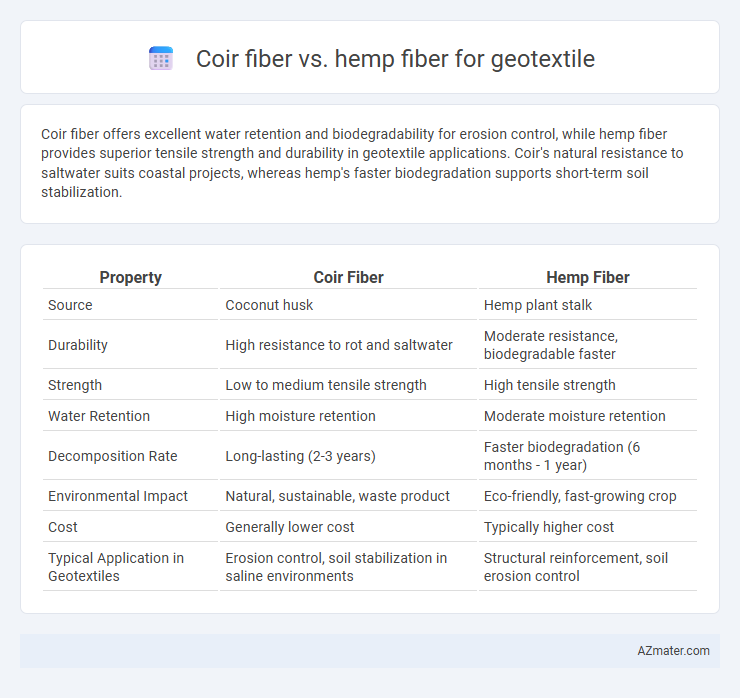Coir fiber offers excellent water retention and biodegradability for erosion control, while hemp fiber provides superior tensile strength and durability in geotextile applications. Coir's natural resistance to saltwater suits coastal projects, whereas hemp's faster biodegradation supports short-term soil stabilization.
Table of Comparison
| Property | Coir Fiber | Hemp Fiber |
|---|---|---|
| Source | Coconut husk | Hemp plant stalk |
| Durability | High resistance to rot and saltwater | Moderate resistance, biodegradable faster |
| Strength | Low to medium tensile strength | High tensile strength |
| Water Retention | High moisture retention | Moderate moisture retention |
| Decomposition Rate | Long-lasting (2-3 years) | Faster biodegradation (6 months - 1 year) |
| Environmental Impact | Natural, sustainable, waste product | Eco-friendly, fast-growing crop |
| Cost | Generally lower cost | Typically higher cost |
| Typical Application in Geotextiles | Erosion control, soil stabilization in saline environments | Structural reinforcement, soil erosion control |
Overview of Coir Fiber and Hemp Fiber
Coir fiber, derived from coconut husks, is highly valued in geotextile applications for its natural durability, water resistance, and high lignin content that enhances biodegradability over time. Hemp fiber, extracted from the stalks of the Cannabis sativa plant, offers superior tensile strength, excellent moisture-wicking properties, and rapid growth, making it a sustainable alternative for erosion control and soil stabilization. Both fibers are biodegradable and environmentally friendly, but coir's higher resistance to microbial degradation contrasts with hemp's mechanical strength and renewability, influencing their suitability in different geotextile uses.
Key Physical Properties Comparison
Coir fiber exhibits high tensile strength ranging from 15 to 25 MPa, moderate elongation of 25-30%, and excellent water retention, making it suitable for erosion control in geotextiles. Hemp fiber offers superior tensile strength between 30 to 60 MPa, lower elongation around 2-4%, and enhanced durability against microbial degradation. Both fibers provide natural biodegradability, but hemp's higher mechanical strength and dimensional stability deliver longer-lasting performance in geotextile applications.
Environmental Impact and Sustainability
Coir fiber, derived from coconut husks, offers high biodegradability and natural resistance to saltwater, making it ideal for coastal geotextile applications with minimal environmental impact. Hemp fiber, known for its rapid growth and low pesticide requirement, provides excellent strength and durability while promoting carbon sequestration during cultivation. Both fibers contribute to sustainable geotextile solutions by reducing reliance on synthetic materials and enhancing soil erosion control through eco-friendly, renewable resources.
Durability and Lifespan in Geotextile Applications
Coir fiber exhibits high resistance to microbial degradation and saltwater exposure, providing a lifespan of up to 3-5 years in geotextile applications, making it suitable for erosion control in coastal areas. Hemp fiber offers superior tensile strength and biodegradability but degrades faster under constant moisture, with an average lifespan of 1-2 years when used in soil reinforcement. The choice between coir and hemp fiber depends on the specific environmental conditions and required durability for the geotextile project.
Water Absorption and Drainage Capabilities
Coir fiber exhibits high water absorption capacity, making it ideal for retaining moisture in geotextile applications, while hemp fiber offers superior drainage capabilities due to its coarse texture and rapid water permeability. The cell structure of coir fibers allows them to hold up to 60% of their weight in water, enhancing soil moisture retention; in contrast, hemp fibers facilitate quicker water flow, reducing waterlogging risks. Combining these fibers can optimize geotextile performance by balancing effective water retention with efficient drainage.
Soil Erosion Control Efficiency
Coir fiber offers superior soil erosion control efficiency due to its high tensile strength, natural biodegradability, and excellent water retention properties, which promote vegetation growth and stabilize soil. Hemp fiber also provides effective erosion control with its robust durability and resistance to microbial degradation, but it generally decomposes faster than coir, potentially reducing long-term soil protection. Studies indicate coir geotextiles maintain soil structure longer in wet environments, making them preferable for extended erosion control applications.
Biodegradability and Decomposition Rates
Coir fiber, derived from coconut husks, exhibits high biodegradability and decomposes within 1 to 3 years in soil, making it ideal for temporary geotextile applications requiring natural erosion control. Hemp fiber, known for its strength and durability, biodegrades slower than coir, typically taking 3 to 5 years, offering longer-lasting soil stabilization but extended environmental persistence. Both fibers are eco-friendly alternatives to synthetic geotextiles, with coir favored for rapid decomposition and hemp suited for enduring structural support.
Cost Effectiveness and Market Availability
Coir fiber offers superior cost-effectiveness for geotextile applications due to its abundant availability in tropical regions and low processing costs compared to hemp fiber, which tends to be more expensive and less widely cultivated. Market availability of coir fiber is significantly higher, with established supply chains primarily in India and Sri Lanka, whereas hemp fiber, despite growing interest, faces regulatory restrictions and limited large-scale production in many countries. These factors make coir fiber a more economically viable and readily accessible choice for geotextile use, especially in price-sensitive infrastructure projects.
Suitability for Different Geotextile Projects
Coir fiber offers excellent suitability for erosion control and slope stabilization due to its high water retention and biodegradability, making it ideal for short to medium-term geotextile projects. Hemp fiber provides superior tensile strength and durability, which enhances its performance in long-term soil reinforcement and heavy load-bearing applications in geotextiles. Both fibers' natural properties influence their selection based on project duration, environmental conditions, and mechanical requirements.
Summary: Choosing the Right Natural Fiber
Coir fiber offers superior durability and water resistance, making it ideal for erosion control and long-term geotextile applications in coastal and wet environments. Hemp fiber provides excellent tensile strength and biodegradability, suited for soil stabilization and short-term projects requiring high breathability. Selecting the right natural fiber depends on project-specific factors such as environmental conditions, longevity requirements, and mechanical performance.

Infographic: Coir fiber vs Hemp fiber for Geotextile
 azmater.com
azmater.com